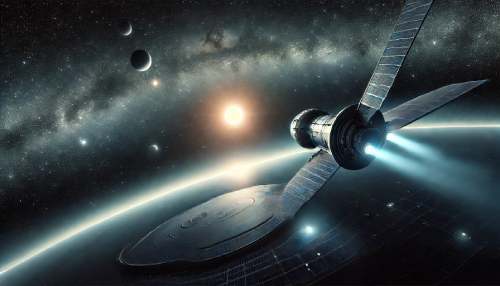Venturing beyond our solar system is a concept that has intrigued humanity for centuries. While current technology makes interstellar travel an extreme challenge, it’s a topic worth exploring from a theoretical perspective. This article delves into the key factors involved in traveling out of the solar system, including the distance, time, speed, and challenges.
1. Distance from the Solar System
To understand what it means to leave the solar system, we first need to define its boundary. The edge of the solar system is typically considered to be the heliopause—the point where the Sun’s solar wind is no longer strong enough to push against the interstellar medium. This region is about 120 astronomical units (AU) from the Sun, where 1 AU is the average distance from the Earth to the Sun, or roughly 93 million miles (150 million kilometers).
After passing the heliopause, you enter the interstellar medium, where the influence of the Sun’s gravity and magnetic fields fade, marking the beginning of interstellar space.
2. How Long Would It Take?
To leave the solar system, let’s first examine our fastest spacecraft: Voyager 1, which was launched in 1977. Voyager 1 is currently moving at around 17 kilometers per second (about 38,000 mph). It took Voyager 1 about 35 years to reach the heliopause, which it crossed in 2012.
If a human were to travel at the same speed, it would take about the same amount of time—35-40 years—to leave the solar system. However, even at this speed, reaching the closest star, Proxima Centauri, would take approximately 73,000 years!
Hypothetical Scenarios:
- At the speed of light (299,792 kilometers per second or 186,282 miles per second), which is the cosmic speed limit according to Einstein’s theory of relativity, it would still take 4.24 years to reach Proxima Centauri, the nearest star system.
- If future technology could allow humans to travel at a significant fraction of light speed, say 10% of the speed of light, the journey out of the solar system would be shortened to about 5 years.
3. What Speed Would You Need?
Currently, Voyager 1 holds the record for the fastest spacecraft, but for human interstellar travel, much higher speeds are required. To make this journey within a human lifetime, speeds much closer to that of light would be needed.
- 100 km/s: At this speed, leaving the solar system would take about 40 years, similar to Voyager 1’s timeline.
- 10% the speed of light: At around 30,000 km/s, you could exit the solar system in about 5 months.
4. Challenges of Traveling Out of the Solar System
Traveling beyond the solar system is not just a matter of speed. There are numerous technical, physical, and biological challenges that humanity would need to overcome.
- Propulsion Technology: Current rocket propulsion systems, including chemical and ion propulsion, are not nearly powerful enough for interstellar travel. Concepts like nuclear fusion propulsion or antimatter propulsion are hypothetical technologies that could push spacecraft to a significant fraction of the speed of light. Another futuristic idea is the solar sail, which uses radiation from the Sun or a powerful laser to propel a spacecraft.
- Energy Requirements: To sustain travel for decades or even centuries, a spacecraft would need vast amounts of energy. This raises the question of power generation, such as nuclear reactors or advanced battery systems.
- Life Support: The spacecraft would need a fully sustainable life support system that could provide air, water, food, and waste recycling for extended periods. In a multi-decade mission, astronauts would also face the issue of aging. This is where ideas like cryogenic sleep or generation ships (where descendants complete the mission) come into play.
- Cosmic Radiation: Space is filled with cosmic rays and other forms of radiation. A long-term journey outside the protective influence of Earth’s magnetic field and atmosphere would expose astronauts to significant health risks. Shielding solutions must be designed to protect against this radiation.
- Psychological and Social Challenges: Space travel, especially for decades, would present unique psychological challenges. The isolation and confinement, as well as the vast distance from Earth, could lead to severe mental health issues.
5. What Would It Be Like to Leave the Solar System?
As you move farther from the Sun, the light dims, and stars become your primary light source. Once you pass the heliopause, you’d be in true interstellar space. The Sun would appear as just another star among billions, and your spacecraft would be free of its gravitational influence.
In terms of human exploration, leaving the solar system would be a groundbreaking achievement, but we are far from that goal today. Still, technology advances rapidly, and what seems like science fiction now may one day become reality.
6. Future Possibilities for Interstellar Travel
Several ambitious projects are already in the planning stages. One example is Breakthrough Starshot, which aims to send tiny, light-propelled nanocrafts at 20% the speed of light toward Alpha Centauri. Although this project would only carry small probes, it could pave the way for future human missions.
Similarly, nuclear fusion propulsion or laser propulsion might revolutionize space travel. These technologies are in early research stages but offer promising ways to reduce the time it takes to leave the solar system.
Conclusion
Exiting the solar system is a monumental challenge that would require decades of travel, advanced propulsion technologies, life support systems, and solutions to radiation exposure and psychological isolation. The distance to the edge of the solar system is immense, but with future advancements, human exploration beyond our solar system may eventually become a reality. Although it may take centuries to perfect, the dream of interstellar travel continues to inspire scientists and space enthusiasts alike.




